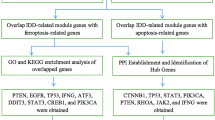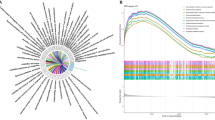Abstract
Lumbar disc herniation (LDH) is the most common condition associated with low back pain, and it adversely impacts individuals’ health. Ferroptosis has recently emerged as a novel factor in the pathogenesis of LDH; however, the specific impacts of ferroptosis on LDH have not been fully elucidated. Ferroptosis-related differentially expressed genes (FRDEGs) were identified from the transcriptomic datasets of LDH. Gene set enrichment analysis (GSEA) was conducted to identify biological mechanism and related pathways. LASSO and SVM-RFE algorithms were applied to detect signature genes. Function of the signature gene was confirmed by RT-qPCR. The CIBERSORT algorithm was used to compare immune infiltration between LDH and normal samples. Correlation analysis between MYB and immune cells was analyzed using the Pearson method. Additionally, we used scRNA-seq to dissect cell clusters and cellular interactions. AUCell scoring was used to analyze the ferroptosis scores of different cell types. We found that MYB, a highly expressed ferroptosis-related gene, was associated with LDH By leveraging bioinformatics analysis. In immune infiltration analysis, the abundance of monocytes and macrophages varied significantly between the LDH group and disc spondylolisthesis (DS) group. MYB was correlated with most immune cells. GSEA revealed MYB was significantly enriched in immune-related pathways. Furthermore, scRNA-seq analysis revealed the presence of eight distinct cell types. AUCell analysis showed that macrophages had a high ferroptosis score. Cell trajectory analysis revealed that chondrocyte 1 was at the beginning of the trajectory, while calcification inhibiting chondrocytes and fibrochondrocytes accumulated along the middle and tail end of the trajectory, respectively. Cell–cell communication analysis identified chondrocyte 1 had an extensive communication network with other clusters and interacted with nucleus pulposus through collagen signaling pathway. Our analysis demonstrated that MYB may be a potential therapeutic target for LDH. This study provides a resource for the orthopedics community that will facilitate additional discoveries directedly toward understanding the pathogenesis process of LDH.








Similar content being viewed by others
Data availability
All data generated during this study are fully available in published database. The datasets generated for this study are available on request to the corresponding author.
References
Almeida-Silva F, Venancio TM (2022) BioNERO: an all-in-one R/Bioconductor package for comprehensive and easy biological network reconstruction. Funct Integr Genomics 22:131–136. https://doi.org/10.1007/s10142-021-00821-9
Boyd LM, Richardson WJ, Chen J et al (2005) Osmolarity regulates gene expression in intervertebral disc cells determined by gene array and real-time quantitative RT-PCR. Ann Biomed Eng 33:1071–1077. https://doi.org/10.1007/s10439-005-5775-y
Bydon M, Moinuddin FM, Yolcu YU et al (2020) Lumbar intervertebral disc mRNA sequencing identifies the regulatory pathway in patients with disc herniation and spondylolisthesis. Gene 750:144634. https://doi.org/10.1016/j.gene.2020.144634
Chin CH, Chen SH, Wu HH et al (2014) cytoHubba: identifying hub objects and sub-networks from complex interactome. BMC Syst Biol 8(Suppl 4):S11. https://doi.org/10.1186/1752-0509-8-s4-s11
Davies BM, Mowforth OD, Smith EK et al (2018) Degenerative cervical myelopathy. BMJ 360:k186. https://doi.org/10.1136/bmj.k186
Fernandes LM, Khan NM, Trochez CM et al (2020) Single-cell RNA-seq identifies unique transcriptional landscapes of human nucleus pulposus and annulus fibrosus cells. Sci Rep 10:15263. https://doi.org/10.1038/s41598-020-72261-7
Fry EA, Inoue K (2019) c-MYB and DMTF1 in cancer. Cancer Invest 37:46–65. https://doi.org/10.1080/07357907.2018.1550090
Gabr MA, Jing L, Helbling AR et al (2011) Interleukin-17 synergizes with IFNγ or TNFα to promote inflammatory mediator release and intercellular adhesion molecule-1 (ICAM-1) expression in human intervertebral disc cells. J Orthop Res 29:1–7. https://doi.org/10.1002/jor.21206
Gao B, Jiang B, Xing W et al (2022) Discovery and application of postnatal nucleus pulposus progenitors essential for intervertebral disc homeostasis and degeneration. Adv Sci 9:e2104888. https://doi.org/10.1002/advs.202104888
George OL, Ness SA (2014) Situational awareness: regulation of the myb transcription factor in differentiation, the cell cycle and oncogenesis. Cancers 6:2049–2071. https://doi.org/10.3390/cancers6042049
Gulati GS, Sikandar SS, Wesche DJ et al (2020) Single-cell transcriptional diversity is a hallmark of developmental potential. Science 367:405–411. https://doi.org/10.1126/science.aax0249
Hoffman RM, Wheeler KJ, Deyo RA (1993) Surgery for herniated lumbar discs: a literature synthesis. J Gen Intern Med 8:487–496. https://doi.org/10.1007/bf02600110
Jin S, Guerrero-Juarez CF, Zhang L et al (2021) Inference and analysis of cell-cell communication using CellChat. Nat Commun 12:1088. https://doi.org/10.1038/s41467-021-21246-9
Jin S, MacLean AL, Peng T et al (2018) scEpath: energy landscape-based inference of transition probabilities and cellular trajectories from single-cell transcriptomic data. Bioinformatics 34:2077–2086. https://doi.org/10.1093/bioinformatics/bty058
Kämpe A, Knebel A, Carlson R et al (2021) Evaluation of the involvement of Th17-cells in the pathogenesis of canine spinal cord injury. PloS One 16:e0257442. https://doi.org/10.1371/journal.pone.0257442
Koroth J, Buko EO, Abbott R et al (2023) Macrophages and intervertebral disc degeneration. Int J Mol Sci 24. https://doi.org/10.3390/ijms24021367
Krut Z, Pelled G, Gazit D et al (2021) Stem Cells and exosomes: new therapies for intervertebral disc degeneration. Cells 10. https://doi.org/10.3390/cells10092241
Lai ZZ, Zhang J, Zhou WJ et al (2023) Identification of potential biomarkers and immune infiltration characteristics in recurrent implantation failure using bioinformatics analysis. Front Immunol 14:992765. https://doi.org/10.3389/fimmu.2023.992765
Li W, Zhao Y, Wang Y et al (2023) Deciphering the sequential changes of monocytes/macrophages in the progression of IDD with longitudinal approach using single-cell transcriptome. Front Immunol 14:1090637. https://doi.org/10.3389/fimmu.2023.1090637
Li Z, Ye D, Dai L et al (2022) Single-Cell RNA sequencing reveals the difference in human normal and degenerative nucleus pulposus tissue profiles and cellular interactions. Front Cell Dev Biol 10:910626. https://doi.org/10.3389/fcell.2022.910626
Ling Z, Liu Y, Wang Z et al (2021) Single-cell RNA-seq analysis reveals macrophage involved in the progression of human intervertebral disc degeneration. Front Cell Dev Biol 9:833420. https://doi.org/10.3389/fcell.2021.833420
Liu Q, Wang R, Hou S et al (2022) Chondrocyte-derived exosomes promote cartilage calcification in temporomandibular joint osteoarthritis. Arthritis Res Ther 24:44. https://doi.org/10.1186/s13075-022-02738-5
Lu S, Song Y, Luo R et al (2021) Ferroportin-dependent iron homeostasis protects against oxidative stress-induced nucleus pulposus cell ferroptosis and ameliorates intervertebral disc degeneration in vivo. Oxid Med Cell Longev 2021:6670497. https://doi.org/10.1155/2021/6670497
Newman AM, Liu CL, Green MR et al (2015) Robust enumeration of cell subsets from tissue expression profiles. Nat Methods 12:453–457. https://doi.org/10.1038/nmeth.3337
Oralová V, Matalová E, Janečková E et al (2015) Role of c-Myb in chondrogenesis. Bone 76:97–106. https://doi.org/10.1016/j.bone.2015.02.031
Qiu X, Mao Q, Tang Y et al (2017) Reversed graph embedding resolves complex single-cell trajectories. Nat Methods 14:979–982. https://doi.org/10.1038/nmeth.4402
Quiles Del Rey M, Mancias JD (2019) NCOA4-mediated ferritinophagy: a potential link to neurodegeneration. Front Neurosci 13:238. https://doi.org/10.3389/fnins.2019.00238
Ricci JA, Stewart WF, Chee E et al (2006) Back pain exacerbations and lost productive time costs in United States workers. Spine 31:3052–3060. https://doi.org/10.1097/01.brs.0000249521.61813.aa
Ritchie ME, Phipson B, Wu D et al (2015) limma powers differential expression analyses for RNA-sequencing and microarray studies. Nucleic Acids Res 43:e47. https://doi.org/10.1093/nar/gkv007
Robinson MD, McCarthy DJ, Smyth GK (2010) edgeR: a Bioconductor package for differential expression analysis of digital gene expression data. Bioinformatics 26:139–140. https://doi.org/10.1093/bioinformatics/btp616
Rogerson A, Aidlen J, Jenis LG (2019) Persistent radiculopathy after surgical treatment for lumbar disc herniation: causes and treatment options. Int Orthop 43:969–973. https://doi.org/10.1007/s00264-018-4246-7
Rothoerl R, Woertgen C, Holzschuh M et al (1998) Macrophage tissue infiltration, clinical symptoms, and signs in patients with lumbar disc herniation. A clinicopathological study on 179 patients. Acta Neurochir 140:1245–1248. https://doi.org/10.1007/s007010050245
Ruiz Amores G, Martínez-Antonio A (2022) Basics on network theory to analyze biological systems: a hands-on outlook. Funct Integr Genomics 22:1433–1448. https://doi.org/10.1007/s10142-022-00907-y
Saberi M, Zhang X, Mobasheri A (2021) Targeting mitochondrial dysfunction with small molecules in intervertebral disc aging and degeneration. GeroScience 43:517–537. https://doi.org/10.1007/s11357-021-00341-1
Schumann B, Bolm-Audorff U, Bergmann A et al (2010) Lifestyle factors and lumbar disc disease: results of a German multi-center case-control study (EPILIFT). Arthritis Res Ther 12:R193. https://doi.org/10.1186/ar3164
Shannon P, Markiel A, Ozier O et al (2003) Cytoscape: a software environment for integrated models of biomolecular interaction networks. Genome Res 13:2498–2504. https://doi.org/10.1101/gr.1239303
Song C, Zhou Y, Cheng K et al (2023) Cellular senescence - molecular mechanisms of intervertebral disc degeneration from an immune perspective. Biomed Pharmacother 162:114711. https://doi.org/10.1016/j.biopha.2023.114711
Sun Z, Liu ZH, Chen YF et al (2013) Molecular immunotherapy might shed a light on the treatment strategies for disc degeneration and herniation. Med Hypotheses 81:477–480. https://doi.org/10.1016/j.mehy.2013.06.014
Szklarczyk D, Gable AL, Nastou KC et al (2021) The STRING database in 2021: customizable protein-protein networks, and functional characterization of user-uploaded gene/measurement sets. Nucleic Acids Res 49:D605–d612. https://doi.org/10.1093/nar/gkaa1074
Van de Sande B, Flerin C, Davie K et al (2020) A scalable SCENIC workflow for single-cell gene regulatory network analysis. Nat Protoc 15:2247–2276. https://doi.org/10.1038/s41596-020-0336-2
Wang F, Cai F, Shi R et al (2016) Aging and age related stresses: a senescence mechanism of intervertebral disc degeneration. Osteoarthr Cartil 24:398–408. https://doi.org/10.1016/j.joca.2015.09.019
Wang J, Huang Y, Huang L et al (2021a) Novel biomarkers of intervertebral disc cells and evidence of stem cells in the intervertebral disc. Osteoarthr Cartil 29:389–401. https://doi.org/10.1016/j.joca.2020.12.005
Wang L, He T, Liu J et al (2021b) Revealing the immune infiltration landscape and identifying diagnostic biomarkers for lumbar disc herniation. Front Immunol 12:666355. https://doi.org/10.3389/fimmu.2021.666355
Wang W, Jing X, Du T et al (2022) Iron overload promotes intervertebral disc degeneration via inducing oxidative stress and ferroptosis in endplate chondrocytes. Free Radic Biol Med 190:234–246. https://doi.org/10.1016/j.freeradbiomed.2022.08.018
Wu XT, Wang YX, Feng XM et al (2022) Update on the roles of macrophages in the degeneration and repair process of intervertebral discs. Joint Bone Spine 90:105514. https://doi.org/10.1016/j.jbspin.2022.105514
Xie F, Wang J, Zhang B (2023) RefFinder: a web-based tool for comprehensively analyzing and identifying reference genes. Funct Integr Genomics 23:125. https://doi.org/10.1007/s10142-023-01055-7
Xu S, Fu H, Weng S et al (2023) Derivation and comprehensive analysis of ageing-related genes in intervertebral disc degeneration for prediction and immunology. Mech Ageing Dev 211:111794. https://doi.org/10.1016/j.mad.2023.111794
Yang H, Liu B, Liu Y et al (2019) Secreted factors from intervertebral disc cells and infiltrating macrophages promote degenerated intervertebral disc catabolism. Spine 44:e520–e529. https://doi.org/10.1097/brs.0000000000002953
Yang RZ, Xu WN, Zheng HL et al (2021) Involvement of oxidative stress-induced annulus fibrosus cell and nucleus pulposus cell ferroptosis in intervertebral disc degeneration pathogenesis. J Cell Physiol 236:2725–2739. https://doi.org/10.1002/jcp.30039
Yu G, Wang LG, Han Y et al (2012) clusterProfiler: an R package for comparing biological themes among gene clusters. OMICS 16:284–287. https://doi.org/10.1089/omi.2011.0118
Yu P, Mao F, Chen J et al (2022) Characteristics and mechanisms of resorption in lumbar disc herniation. Arthritis Res Ther 24:205. https://doi.org/10.1186/s13075-022-02894-8
Zhang X, Huang Z, Xie Z et al (2020) Homocysteine induces oxidative stress and ferroptosis of nucleus pulposus via enhancing methylation of GPX4. Free Radic Biol Med 160:552–565. https://doi.org/10.1016/j.freeradbiomed.2020.08.029
Zhang Y, Han S, Kong M et al (2021) Single-cell RNA-seq analysis identifies unique chondrocyte subsets and reveals involvement of ferroptosis in human intervertebral disc degeneration. Osteoarthr Cartil 29:1324–1334. https://doi.org/10.1016/j.joca.2021.06.010
Zhang Y, Huang X, Qi B et al (2022) Ferroptosis and musculoskeletal diseases: “Iron Maiden” cell death may be a promising therapeutic target. Front Immunol 13:972753. https://doi.org/10.3389/fimmu.2022.972753
Author information
Authors and Affiliations
Contributions
Zhenyu and Ziqiang Lu analyzed the data and wrote the manuscript. Ziqiang Lu collected the data.
Corresponding author
Ethics declarations
Ethics approval and consent to participate
Not applicable
Consent for publication
All authors approved this submission.
Competing interests
The authors declare no competing interests.
Additional information
Publisher’s note
Springer Nature remains neutral with regard to jurisdictional claims in published maps and institutional affiliations.
Rights and permissions
Springer Nature or its licensor (e.g. a society or other partner) holds exclusive rights to this article under a publishing agreement with the author(s) or other rightsholder(s); author self-archiving of the accepted manuscript version of this article is solely governed by the terms of such publishing agreement and applicable law.
About this article
Cite this article
Lu, Z., Zheng, Z. Integrated analysis of single-cell and bulk RNA sequencing data identifies the characteristics of ferroptosis in lumbar disc herniation. Funct Integr Genomics 23, 289 (2023). https://doi.org/10.1007/s10142-023-01216-8
Received:
Revised:
Accepted:
Published:
DOI: https://doi.org/10.1007/s10142-023-01216-8




